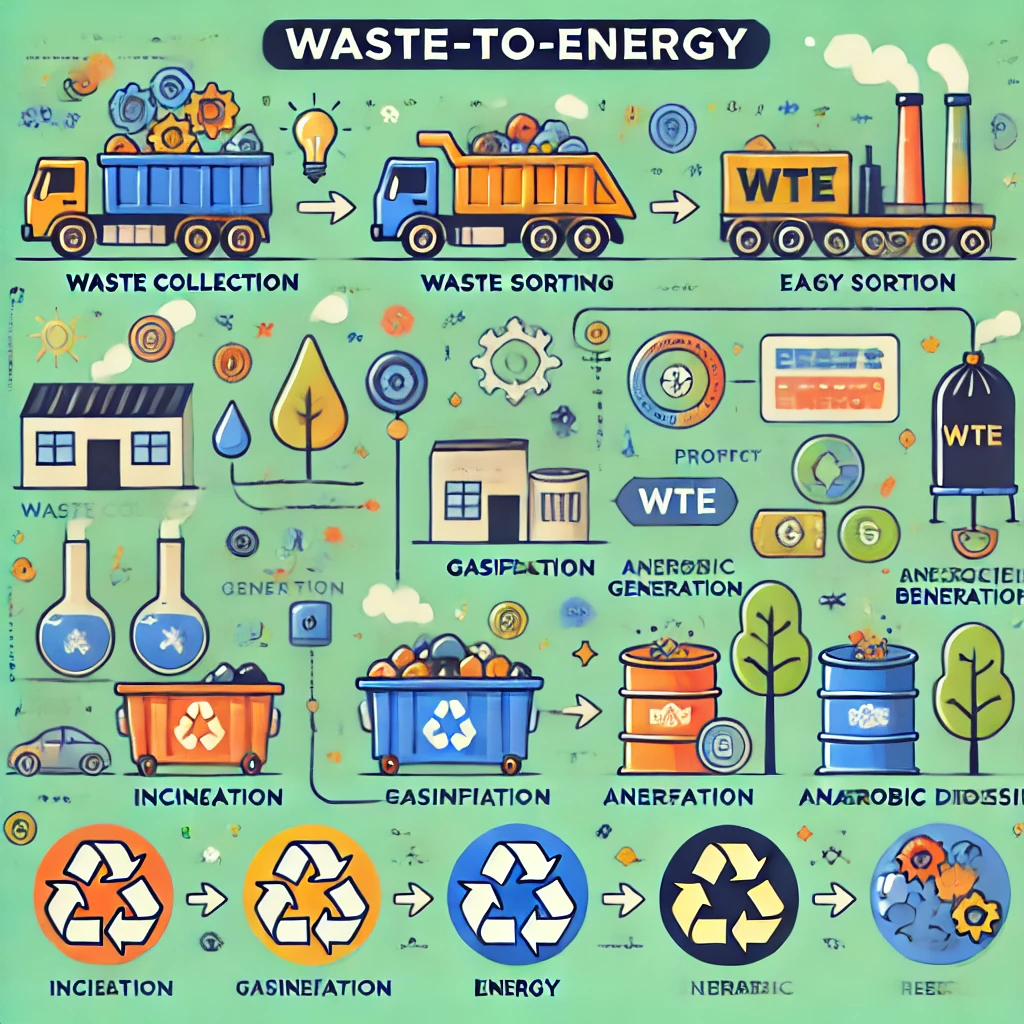Introducing
1. ビジネス概要:
ゴミ発電(WTE)プロジェクトの投資および共同事業
目標:
• ゴミをエネルギーに変換し、持続可能な電力供給と廃棄物管理の問題を解決する。
• 電力を国内市場や地域市場に販売することで、安定した収益源を確保する。
• 廃棄物から生産される副産物(燃料資源や再生可能な原材料)を製造し、販売する。
2. 投資・融資機関の役割
資金調達方法:
• 政府資金: タイやベトナムでは、再生可能エネルギーと廃棄物管理の分野で政府からの助成金や補助金を受けられる場合があります。また、カーボンクレジット市場を利用して、排出削減に対するインセンティブも活用可能です。
• 国際金融機関: アジア開発銀行(ADB)や世界銀行(World Bank)などの国際機関が、再生可能エネルギーやインフラプロジェクトに対して長期融資や低金利融資を提供しています。これらの機関との協力により、WTEプロジェクトの資金を調達できます。
• 民間投資家・ファンド: プライベートエクイティファンドや再生可能エネルギーに特化した投資ファンドを通じて、プロジェクトへの投資を集めることができます。特に、地域の廃棄物処理能力向上に貢献するプロジェクトは、ESG投資として魅力的です。
共同事業の形成:
• タイやベトナムの地元企業との共同事業を形成し、技術ノウハウや運営管理を提供する日本や他国の企業と連携します。これにより、地域に根差した運営と国際的な技術力の融合が可能となります。
• 共同事業を通じて、地元企業はインフラ提供や運営管理を担い、国際パートナーは資金調達や技術提供、マーケティングを担当します。
3. ゴミ発電プロジェクトの構成
技術とインフラ:
• 廃棄物処理施設の建設: タイやベトナムの主要都市や産業地域に、廃棄物処理施設を建設し、発電施設と併設します。廃棄物を選別し、燃料として使用できる部分を効率的に利用します。
• 発電技術: 廃棄物からエネルギーを生成するための最新技術を導入します。これには、焼却による熱エネルギーを電力に変換する技術や、ガス化技術が含まれます。
• 副産物の再利用: ゴミ発電プロセスから得られる灰や廃熱を、セメント材料や地域暖房、バイオ燃料製造に再利用します。
Key notes
- リスク管理と事業成長の戦略
- 具体的な市場展開
- ビジネスモデル
- WTEの種類
ビジネスモデル:
1. 電力販売: 発電された電力は、タイやベトナムの電力網に接続され、国際的な電力市場や地域の工場・施設へ売電します。固定価格買取制度(FIT)を利用して、長期的な電力売買契約を締結します。
2. 燃料資源の製造・販売: 廃棄物からバイオガスやバイオ燃料を製造し、地域の工場や国際市場で販売します。特にバイオガスは、産業燃料や輸送用燃料としての需要が高まっています。
3. カーボンクレジットの活用: ゴミ発電により削減されたCO2排出量をクレジット化し、カーボンクレジット市場での売買を行います。タイやベトナムの二国間クレジット制度(JCM)を利用して、日本などの先進国と連携し、クレジットの取引を促進します。
4. 具体的な市場展開
タイ市場:
• タイは廃棄物処理の需要が高まっており、特にバンコクや主要都市ではWTE技術の導入が求められています。タイ政府の再生可能エネルギー政策もあり、ゴミ発電は政策支援を受けやすい分野です。
• パートナーシップ: タイ国内のエネルギー企業や自治体と協力し、廃棄物処理施設を展開。電力の固定価格買取制度や政府補助金を活用し、長期的な売電契約を締結します。
ベトナム市場:
• ベトナムでも、都市部のゴミ処理能力の不足が課題となっており、政府は再生可能エネルギーの導入を推進しています。廃棄物発電プロジェクトは、ベトナムの持続可能なエネルギー政策に合致しています。
• パートナーシップ: ベトナムの産業団地や地方自治体との連携を通じて、廃棄物発電施設を構築。国際的なカーボンクレジット市場と連携して、プロジェクトの経済性を高めます。
WTEの種類
Waste-to-Energy(WTE)技術には、さまざまな発電方法があり、各国で異なる技術が採用されています。以下に、WTE技術における主な発電の種類と、それぞれの特徴、さらに世界との比較についてまとめます。
WTE技術の発電の種類
- 焼却(Incineration)
- 概要: 廃棄物を高温で燃焼させ、その熱を利用して蒸気を生成し、タービンを回して電力を発生させる方法。
- 特徴:
- 高い発電効率(通常20-30%)。
- 残渣は灰として残るが、埋立地に送られる量は大幅に減少。
- 排出ガス処理が必要であり、環境への配慮が求められる。
- 世界の状況:
- ヨーロッパや日本では広く普及しており、先進的な排出ガス処理技術を持つ。
- ガス化(Gasification)
- 概要: 有機廃棄物を低酸素環境下で熱分解し、生成されるシンガスを利用して発電する方法。
- 特徴:
- シンガスは化学原料としても利用可能。
- 高温での処理により、廃棄物からの回収率が高い。
- 残渣は少なく、利用可能な資源に変わる。
- 世界の状況:
- 北米やアジアの一部で試験運用されており、商業化が進んでいる。
- 嫌気性消化(Anaerobic Digestion)
- 概要: 微生物による有機物の分解を通じて、バイオガス(主にメタン)を生成し、発電に利用する方法。
- 特徴:
- バイオガスは電気、熱、または車両燃料として利用可能。
- 有機廃棄物の処理と資源回収を同時に実現。
- 世界の状況:
- 欧州では農業廃棄物や食品廃棄物の処理に利用されている。
世界との比較
- 発展途上国:
- WTE技術はまだ普及が進んでいないが、地域によっては廃棄物の管理が課題であり、今後の導入が期待される。
- 燃焼炉を使用した焼却施設が増加しつつある。
- 先進国:
- ヨーロッパではWTE技術が広く採用され、特にスウェーデンやドイツでは、廃棄物からのエネルギー生産が重要視されています。
- 日本も先進的な焼却技術を持ち、廃棄物の資源化に力を入れています。
- 環境規制:
- WTE技術の導入には、各国の環境規制や基準が影響を与えます。特に、排出ガスの基準が厳しい地域では、高度な処理技術が求められます。
まとめ
WTE技術は、廃棄物をエネルギー源として利用する効果的な方法であり、発電の種類には焼却、ガス化、嫌気性消化があります。各国の状況によって異なる技術が導入されていますが、環境問題への対応や資源の効率的な利用が求められています。今後も、技術の進化とともに、WTEの導入が進むことが期待されます。
焼却型Waste-to-Energy(WTE)技術とプラズマ利用技術は、廃棄物をエネルギーに変換するための異なるアプローチを持っています。それぞれの特徴、利点、欠点を比較してみましょう。
1. 焼却型Waste-to-Energy
概要

- 廃棄物を高温で燃焼させ、その熱を利用して蒸気を生成し、タービンを回して電力を発生させる方法。
特徴
- 発電効率: 通常20-30%。
- 残渣: 焼却後の灰は埋立地に送られる。
- 排出ガス処理: 有害物質(ダイオキシンやNOx)の排出を抑えるための高度な処理が必要。
利点
- 技術の成熟度: 多くの国で実績があり、技術が確立している。
- エネルギー生産: 大量の廃棄物を処理し、エネルギーを生産できる。
- 廃棄物削減: 廃棄物の体積を大幅に減少させることが可能。
欠点
- 環境への影響: 排出ガスや灰の処理が必要で、環境への影響が懸念される。
- 資源の損失: リサイクル可能な資源を焼却してしまう可能性がある。
2. プラズマ利用技術
概要
- プラズマアークを用いて、廃棄物を非常に高温(数千度)で処理し、ガス化や溶融を行う方法。生成されたシンガスはエネルギーとして利用されます。
特徴
- 発電効率: 高効率のエネルギー生成が可能(具体的な値は技術による)。
- 残渣: 溶融した廃棄物はガラス質の残渣として固化し、有害物質を含まない形で処理される。
利点
- 高温処理: 有害物質を完全に分解し、環境への影響を最小限に抑える。
- 資源回収: プラズマ技術を用いることで、金属などの資源を回収しやすい。
- 多様な廃棄物処理: リサイクルが難しい廃棄物も処理可能。
欠点
コスト: プラズマ技術の導入コストが高く、初期投資が大きい。
事故多発、高熱処理管理が難しい
技術の成熟度: 焼却技術に比べると、商業化が進んでいる国は少ない。
WTE Technologies and Types of Energy Generation
- Incineration
- Overview: This method involves burning waste at high temperatures to produce steam, which drives turbines to generate electricity.
- Features:
- High energy recovery efficiency (typically 20-30%).
- Results in ash and flue gas, requiring treatment for harmful emissions.
- Global Context: Widely used in Europe and Japan, with advanced flue gas treatment technologies in place.
- Gasification
- Overview: Organic waste is thermally decomposed at high temperatures in a low-oxygen environment to produce synthetic gas (syngas).
- Features:
- The syngas can be used to generate electricity or as a chemical feedstock.
- High recovery rates for waste materials.
- Global Context: Growing adoption in North America and parts of Asia, with ongoing commercial development.
- Anaerobic Digestion
- Overview: This process uses microorganisms to break down organic waste in the absence of oxygen, producing biogas (mainly methane) and digestate.
- Features:
- Biogas can be used for electricity generation, heating, or upgraded to biomethane.
- Effective for treating organic waste.
- Global Context: Commonly used in Europe for agricultural and food waste treatment.
Comparison with Global Context
- Developing Countries:
- WTE technologies are not as widespread, but some regions are beginning to adopt incineration and gasification to address waste management challenges.
- Developed Countries:
- Europe has successfully integrated WTE technologies, particularly incineration, into their waste management strategies, with countries like Sweden and Germany leading the way.
- Japan also has advanced incineration technologies and is focused on resource recovery from waste.
- Environmental Regulations:
- The adoption of WTE technologies is influenced by environmental regulations. Regions with stringent emissions standards require advanced treatment technologies.
Summary
WTE technologies play a crucial role in converting waste into energy, with various methods such as incineration, gasification, and anaerobic digestion. Their adoption varies globally based on technological maturity, environmental policies, and economic considerations. As the need for sustainable waste management solutions increases, the global interest in WTE technologies is likely to grow.
Comparison Between Incineration and Plasma Technology in Waste-to-Energy
1. Overview
- Incineration: Waste is burned at high temperatures to produce steam, which generates electricity.
- Plasma Technology: Waste is subjected to extremely high temperatures (thousands of degrees Celsius) using plasma arcs to gasify or melt the material.
2. Process
- Incineration: Combustion of waste followed by energy recovery through steam turbines.
- Plasma Technology: Plasma arcs break down waste into syngas and molten slag, which can be utilized or safely disposed of.
3. Energy Recovery Efficiency
- Incineration: Typically achieves energy recovery efficiencies of 20-30%.
- Plasma Technology: Can achieve higher efficiency, depending on the design and operation.
4. Residual Waste
- Incineration: Produces ash, which needs to be disposed of properly; potential for resource recovery is limited.
- Plasma Technology: Produces minimal residual waste (slag), which can be utilized in construction or land reclamation.
5. Environmental Impact
- Incineration: Requires advanced air pollution control systems to reduce harmful emissions (e.g., dioxins, furans, NOx).
- Plasma Technology: Lower emissions of harmful pollutants due to complete destruction of organic compounds; more environmentally friendly if managed properly.
6. Resource Recovery
- Incineration: Limited potential for recovering valuable materials; mainly focused on energy recovery.
- Plasma Technology: Allows for the recovery of metals and other materials from waste; higher potential for resource recovery.
7. Technology Maturity
- Incineration: Well-established technology with widespread use and a proven track record.
- Plasma Technology: Emerging technology with ongoing research and pilot projects; not yet widely adopted commercially.
8. Cost
- Incineration: Generally lower initial capital costs compared to plasma technology.
- Plasma Technology: Higher initial capital investment due to the complexity of plasma systems.
9. Operational Complexity
- Incineration: Relatively straightforward operational requirements; many facilities in operation.
- Plasma Technology: More complex operation and maintenance; requires specialized knowledge and training.
Summary
Plasma technology, while still emerging, offers higher energy efficiency and better environmental outcomes, as it allows for more complete destruction of harmful compounds and recovery of valuable resources. However, its higher costs and operational complexity can be barriers to widespread adoption.
Incineration is a mature and widely used technology that effectively reduces waste volume and generates energy, but it has limitations in resource recovery and potential environmental impacts that require careful management.


